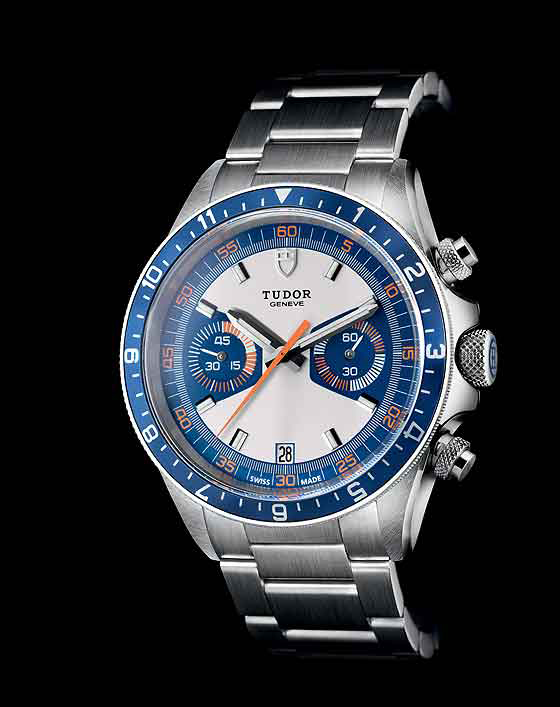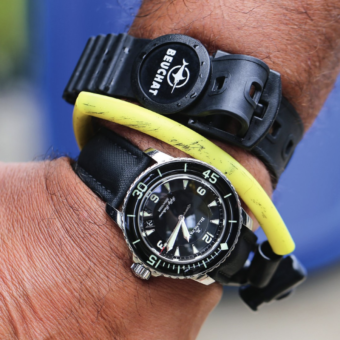Tudor, to its credit, has become one of the leading watch brands for historical recreations and re-interpretations of vintage watches in past few years. And this accomplishment, while exciting for many consumers looking to buy a vintage-inspired watch, or specifically a historically fostered Tudor, is a direct result of the successful designs Tudor produced alongside its sister brand Rolex during the previous century. From the popular Tudor Heritage Black Bay diver, to the Heritage Ranger sports watch, to the more recently released Heritage Advisor alarm watch, Tudor continues to take its most popular designs from its history, and produce contemporary watches with the same codes.
The same is true with the very popular Tudor Heritage Chrono series, first released at Baselworld 2010; the Blue variant we’ll be covering today was released in 2013. This modern watch is based heavily on the Tudor Oysterdate Chronograph (Ref. 7169/0, above) produced from 1971 to 1977 — a very funky 1970s chronograph that is today one of the most sought after vintage Tudors available. This original ‘70s timepiece, characterized by its very distinctive dial, rotating blue bezel, and its nickname “Monte Carlo,” for its inspiration and role in Formula 1 racing, is out of reach for many vintage-watch enthusiasts, so Tudor introduced this modern Heritage Chrono to fill the modern craving for this now-famous reference.
The modern Tudor Heritage Chrono (Ref. 70330B, above), as you will notice, is strikingly similar to the original Ref. 7169/0. With a 42-mm Oyster case and thick bracelet, this watch protects its inner workings with interesting steel-grip-covered screw-down pushers and crown. Within is the Tudor Caliber 2892 — a Tudor-finished ETA 2892 base with a Dubois-Dépraz 2054 module attached — a solid workhorse of a movement engineered for daily wear and holding a 42-hour power reserve. Within the rotating 12-hour blue bezel used for tracking two time zones is the fascinating, heritage-inspired dial. With a blue outer minute ring with orange Arabic numerals at every five-minute mark, two subdials for 45 chronograph minutes (at 9 o’clock) and small seconds (at 3 o’clock), and a host of other accents like the baton hands and thick hour markers, the heritage of the original “Monte Carlo” shines through brightly. Other features to notice are the date window at the 6 o’clock position, the orange central-seconds chronograph hand, and the corporate Tudor Shield logo at the top of the dial. This watch can be found at various dealers for around $3,300.
In comparison to the original reference this modern watch is based upon, if you were to put the two next to one another and ask a layperson to point out the vintage model, he or she might not have an easy task. From the graduated 12-hour blue bezel, to the endless orange, blue, and off-white accents on the dial, this modern watch certainly has worked to faithfully reproduce the design elements that have become so popular among vintage “Monte Carlo” collectors today. The few notable differences are the switching of the subdials (45-min now at the 6 o’clock, small seconds at the 3 o’clock), the absence of the “cyclops” date window over the 6 o’clock date indicator, and the modern steel grip of the crown and pushers as compared to the previous ones with a more historically traditional Rolex/Tudor design. There are also a few other small changes, such as an overall more modern finishing, a thicker and more integrated steel bracelet (with the option of a Tudor produced NATO-style strap, as above and below), and slightly modified baton hands typical of the modern Tudor brand.
In the past few years, Tudor has set out to produce an array of vintage-inspired timepieces for the fast-growing market of consumers looking for a “watch with a story.” It is this strategy that has brought Tudor, along with a few other brands, a considerable degree of modern success among watch aficionados. While the brand continues to produce more contemporary pieces like the Pelagos, North Flag, and Fastrider Black Shield to push its designs forward, Tudor still puts much of its focus on paying homage to its history (and attracting a fair amount of collectors’ attention) with its more historical series.
The Tudor Heritage Chrono Blue has played an integral part in this strategy, and has offered many consumers a piece of the “Monte Carlo” history and look for a fraction of the vintage model’s price. Add this series to the even more popular Rangercollection, and to the almost universally admired Tudor Heritage Black Bay dive watches, and you’ll find that the brand is catering to almost every segment of watch lovers. Now it is only a question of which historical series Tudor will revive next, and how soon it plans to do so.
For our most recent article, in which I compare the Alpina Seastrong Diver Heritage to its vintage counterpart, click here.
Caleb Anderson is a freelance writer for various publications. Since first learning about horology, he has garnered extensive knowledge on vintage watches, and spends much of his time sharing his opinions within the field. Currently located near New York City, he is a persistent student in all things historical, a writer on many topics, and a casual runner.











